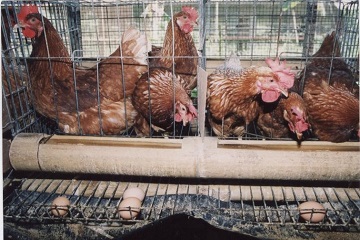IPB Researchers Use Enzyme to Reduce Ammonia Gas Waste from Poultry Farms

High nitrogen content in poultry manure indicates the imperfect digestion or the excessive protein in poultry feed. Professor of Department of Nutrition and Feed Technology, Faculty of Animal Science Bogor Agricultural University (IPB), Prof. Sumiati explained not all protein consumed by chickens can be absorbed and be used by the body. Some will be excreted as the form of ammonia compounds in chicken manure. Excessive nitrogen indicated there is serious contamination in the environment, because excessive nitrogen will produce ammonia which is toxic.
“To reduce N excretion (ammonia source) can be done by adding mannanase enzyme. This addition of mannanase enzyme in low-protein feed for laying hens (contain palm kernel cake) has purpose to decrease the level of ammonia and Eschericia coli bacteria (one of pathogenic bacteria)” she conveyed.
Mannanase enzyme is required to break down mannan polysaccharide content in palm kernel cake into mannan oligosaccharide. Produced mannan oligosaccharide is very useful as prebiotic or food for Lactobacillus sp. bacteria (a good bacteria), while in other hand also inhibit the growth of bad bacteria (pathogenic bacteria).
“The increasing number of Lactobacillus inside in gastrointestinal tract is desirable. Because it will produce high amount of organic acids and positively charged hydrogen ions in gastrointestinal tract and also in manure, so it can bind ammonia manure become ammonium, ultimately reduce ammonium excretion,” she explained.
Rendy Setiawan from Masters Program of Nutrition and Feed Sciences, supervised by Prof. Sumiati and the late Prof. Adrizal (Professor of Faculty of Animal Sciences Universitas Jambi), evaluated the effect of this addition of mannanase enzyme. His research’s objective is to mitigate or to decrease the level of ammonia and Eschericia coli bacteria.
This researcher raised 236 ISA Brow chickens which were divided into two group of treatments. Those chickens were given feed treatment that contain 15% protein with mannanase addition (0.05%) and without mannanase addition. Based on his research, he explained that mannanase supplementation did not has significant effect on performance parameter (feed intake, eggs production, egg’s weight, and FCR (Food Conversion Ratio)) that measured on 31 to 35 weeks old. However, it has significant effect on daily feed intake and FCR when the chickens were 42 to 45 weeks old.
“Mannanase addition of 0.05% in low-protein feed fro laying hens (contain palm kernel cake) can reduce ammonia production by 24.8 percent and reduce pathogenic bacteria (Ascheria coli) by 61 percents,” he stated. (qa)



